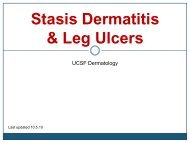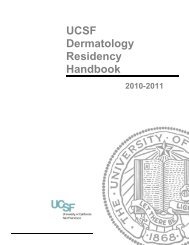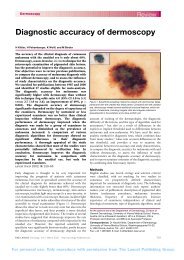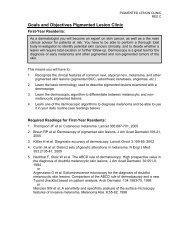who-eortc classification for cutaneous lymphomas - Dermatology
who-eortc classification for cutaneous lymphomas - Dermatology
who-eortc classification for cutaneous lymphomas - Dermatology
Create successful ePaper yourself
Turn your PDF publications into a flip-book with our unique Google optimized e-Paper software.
into either of these provisional entities the designation PTL, unspecified, is maintained. In all cases a<br />
diagnosis of MF must be ruled out by complete clinical examination and an accurate clinical history.<br />
Primary <strong>cutaneous</strong> aggressive epidermotropic CD8-positive cytotoxic T-cell lymphoma<br />
(provisional entity)<br />
Definition<br />
CTCL characterized by a proliferation of epidermotropic CD8-positive cytotoxic T-cells and an<br />
aggressive clinical behavior. 25,26 Differentiation from other types of CTCL expressing a CD8-positive<br />
cytotoxic T-cell phenotype, as observed in more than 50% of patients with pagetoid reticulosis, and<br />
rare cases of MF, LyP, and C-ALCL, is based on the clinical presentation and clinical behavior. 25 In<br />
these latter conditions no difference in clinical presentation or prognosis between CD4+ and CD8+<br />
cases is found.<br />
Clinical features<br />
Clinically, these <strong>lymphomas</strong> are characterized by the presence of localized or disseminated eruptive<br />
papules, nodules and tumors showing central ulceration and necrosis or by superficial, hyperkeratotic<br />
patches and plaques. 16, 25 (Fig. 6A). The clinical features are very similar to those observed in patients<br />
with a <strong>cutaneous</strong> γ/δ T-cell lymphoma and cases described as generalized pagetoid reticulosis (Ketron-<br />
Goodman type) in the past. 32 These <strong>lymphomas</strong> may disseminate to other visceral sites (lung, testis,<br />
central nervous system, oral mucosa), but lymph nodes are often spared. 25<br />
Histopathology<br />
Histologically these <strong>lymphomas</strong> show an acanthotic or atrophic epidermis, necrotic keratinocytes,<br />
ulceration and variable spongiosis, sometimes with blister <strong>for</strong>mation. 16,25 Epidermotropism is often<br />
pronounced ranging from a linear distribution to a pagetoid pattern throughout the epidermis (Fig. 6B).<br />
Invasion and destruction of adnexal skin structures are commonly seen. Angiocentricity and<br />
angioinvasion may be present. Tumour cells are small-medium or medium-large with pleomorphic or<br />
blastic nuclei.<br />
Immunophenotype<br />
The tumor cell have a betaF1+, CD3+, CD8+, granzyme B+, per<strong>for</strong>in+, TIA-1+, CD45RA+, CD45RO-<br />
, CD2-, CD4-, CD5-, CD7-/+ phenotype. 11,16,25,26,32 (Fig. 6C and 6D). EBV is generally negative.<br />
21
















